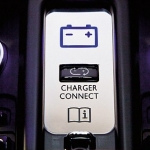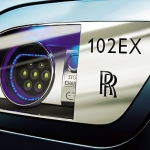The sustainable approach to vehicle design and manufacture dictates that the best possible allocation of resources is used. In the rush to create and build environmentally-friendly cars, it seems as though some may have forgotten this principle.
The Rolls-Royce Phantom Experimental Electric, or 102EX, is the iconic motor marque’s foray into the world of electric cars. Spurred on by the policy and funding initiative from the Energy and Climate Change Secretary, motor manufacturers are being attracted into the segment with the promise of new sales. Whilst some are possibly inherently more able to compete in this sector, the super luxury brands also need to move towards this model type in order to look to the future.
Rolls-Royce has released details and photographs of its entrant. Rather than the existing 6.75 litre V12 engine and 22-gallon fuel tank, it is powered by two electric motors supplied with power from 96 rechargeable nickel-cobaltmanganese batteries. Where one would normally find the fuel cap, there is a five-pin socket. However the power lead is immaterial if the Rolls-Royce is parked above an induction charging pad. This can wirelessly charge the batteries from up to six inches away. Domestic electric charges the bank fully in twenty hours, with an industrial three-phase doing the job in an eight-hour day. A glowing blue light flashes next to the socket and on the central console inside the cabin, alerting to the fact that the car is charging, and glows blue when full.
Obvious advantages are its zero emissions, no gears, and ensuing increased torque. However some highlights of the disadvantages of such a vehicle have led people to question whether this really does lead to an improvement in the stewardship of the world’s resources.
The battery bank of the 102EX weighs more than half a ton, which is almost 200lb more than the Phantom’s V12 and transmission. This decrease in power to weight ratio will make an impact on overall fuel efficiency.
Top speed is just 100 mph, not the 149 mph of the conventional model. It also has a range of just 124 miles after that twenty-hour charge. The use of time resources is thus also questioned.
Also, the debate over electricity versus hydrogen as the fuel source for the future is still one that has not yet been won by electricity.
The cost of ownership of this car, at £570,000 is almost double the £285,000 it costs to buy the conventional Phantom. The investment in the development of this car is also questionable, given the fact that only 106 plug-in cars were sold across the whole country in the third quarter last year. Further questions can be pointed at the subsidies given to fund electric car purchases, if grants are indeed the right way to allocate cash. This is particularly pertinent given that renewable energy is not yet available in sufficient quantities to fuel this need and so fossil fuels are still burnt in order to generate that electricity.
Surely a better use of economic resources would be to hire a more traditional Rolls-Royce from the range at Signature Car Hire. The beautiful white Rolls-Royce Phantom or Rolls-Royce Phantom Drophead make a much smarter allocation of your budget.



